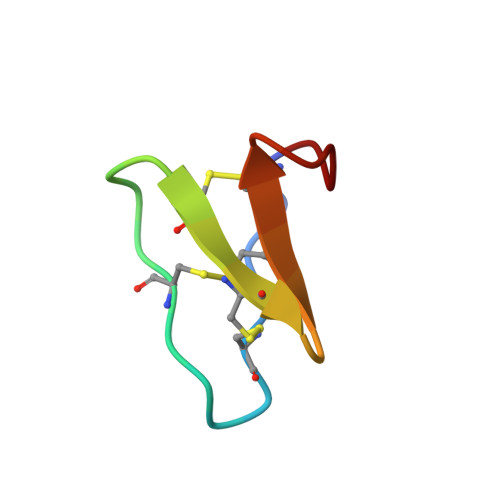A Synthetic mirror image of kalata B1 reveals that cyclotide activity is independent of a protein receptor.
Sando, L., Henriques, S.T., Foley, F., Simonsen, S.M., Daly, N.L., Hall, K.N., Gustafson, K.R., Aguilar, M.I., Craik, D.J.(2011) Chembiochem 12: 2456-2462
- PubMed: 21928440
- DOI: https://doi.org/10.1002/cbic.201100450
- Primary Citation of Related Structures:
2JUE - PubMed Abstract:
Featuring a circular, knotted structure and diverse bioactivities, cyclotides are a fascinating family of peptides that have inspired applications in drug design. Most likely evolved to protect plants against pests and herbivores, cyclotides also exhibit anti-cancer, anti-HIV, and hemolytic activities. In all of these activities, cell membranes appear to play an important role. However, the question of whether the activity of cyclotides depends on the recognition of chiral receptors or is primarily modulated by the lipid-bilayer environment has remained unknown. To determine the importance of lipid membranes on the activity of the prototypic cyclotide, kalata B1, we synthesized its all-D enantiomer and assessed its bioactivities. After the all-D enantiomer had been confirmed by (1)H NMR to be the structural mirror image of the native kalata B1, it was tested for anti-HIV activity, cytotoxicity, and hemolytic properties. The all-D peptide is active in these assays, albeit with less efficiency; this reveals that kalata B1 does not require chiral recognition to be active. The lower activity than the native peptide correlates with a lower affinity for phospholipid bilayers in model membranes. These results exclude a chiral receptor mechanism and support the idea that interaction with phospholipid membranes plays a role in the activity of kalata B1. In addition, studies with mixtures of L and D enantiomers of kalata B1 suggested that biological activity depends on peptide oligomerization at the membrane surface, which determines affinity for membranes by modulating the association-dissociation equilibrium.
- Institute for Molecular Bioscience, The University of Queensland, Brisbane, QLD, Australia.
Organizational Affiliation:

















